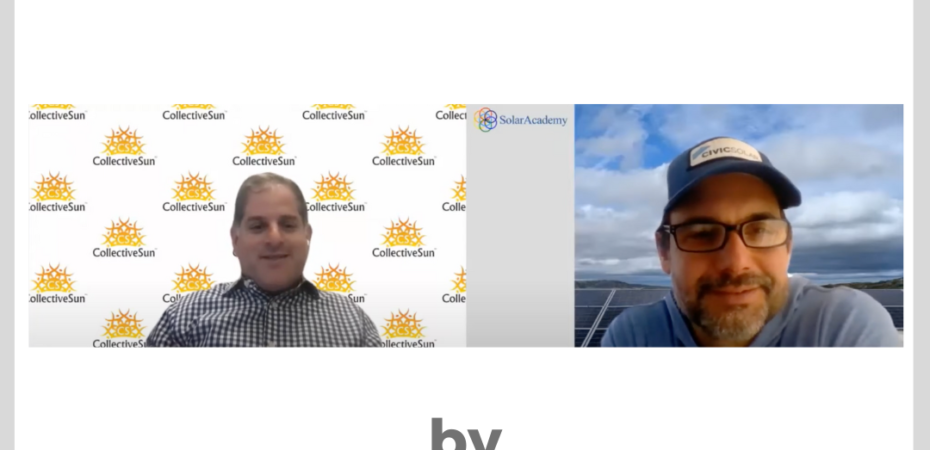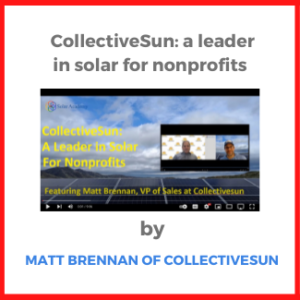In this conversation, Kerim Baran of SolarAcademy talks to Matt Brennan, VP of Sales at CollectiveSun. CollectiveSun is a leader in solar financing for nonprofits in the US. Their customers include churches, synagogues, mosques, as well as many other types of nonprofits like medical centers and schools.
CollectiveSun’s core offering provides a 12-16% tax credit discount to nonprofits that otherwise would be left on the table. On top of this, CollectiveSun is also offering other types of services to finance the remaining 84-88% of the solar system cost.
Their offerings include values aligned low-interest-rate solar loans to nonprofits as well as 20-year Power Purchase Agreements (PPAs) where CollectiveSun owns and operates the systems on behalf of the nonprofits. The 4 minute video mentioned in this conversation regarding the Solar Power Agreement is here.
The full transcript of the conversation can be found here:
SolarAcademy: Hi everyone. This is Kerim, Kerim Baran with SolarAcademy. I have with me my friend and colleague Matt Brennan from CollectiveSun. Matt. Good time.
Matt Brennan: Thank you, Kerim, appreciate the opportunity to talk with you. Thanks.
SolarAcademy: So we’ve known each other for over half a decade and we’ve both been in the solar industry for over a decade at this point. And as far as I know, you guys are the leader in the space of solar for nonprofits. I wanted to talk to you a little bit about that market and what you guys are seeing about what’s happening. Solar is growing rapidly in the country and around the world. So let’s talk a little bit about the market, what you guys are up to and what’s coming.
Matt Brennan: Thanks. I mean, it really is a growing market. There were 1.6 million, roughly, tax exempt organizations in the United States and you know, we’ve done less than 1% of that. So from both the perspective of solar contractors across the country, clearly there’s a big opportunity there, but also from nonprofits themselves who want to go solar.
So many of them haven’t and, you know, in my experience, nonprofits will always do it as long as, of course, they have site suitability, they have a roof they can use, or they own the building, they have land, they can actually do it. But a lot of times it comes down to financing. But the interest is there, they would like to do this. So we just see this as continuing to grow.
SolarAcademy: Yeah. I mean, I was doing a little bit of Googling myself, and I was really surprised to see that there are more than a million and a half nonprofits in the country and probably half-a-million or so churches, synagogues and communities of faith – less than 1% of them have gone solar. US-wide I guess if you look at residential homes, we’re at 2-3%, maybe. We’re a little higher than that in California. Probably close to 10-15% and around 30-35% in Hawaii, but, there’s still so much to be done.
So how do you guys help nonprofits go solar? Tell us a little bit about your core product. If I remember correctly you have the Solar Power Agreement which you’ve been selling for a while in the market.
Matt Brennan: Yeah. We call it a Solar Power Agreement. It’s an SPA. We’ll provide a link to more information. We have a nice four minute video that really summarizes it because we don’t really want to do that here. We’ll put that in the description when we’re done.
Early on what was our goal? Well, it was to put as many panels on nonprofits across the country as we could. And financing was always a barrier. But even for the organizations, the nonprofits that had funding, they said they’d identified cash reserves, construction financing, however they did that, they still wanted a way to monetize the tax credit. They want to lower the cost, just like a business does or a homeowner. And nonprofits are basically penalized for being a nonprofit. They can’t participate in that. So our solution was to help them monetize part of that tax credit. And we do that through our Solar Power Agreement.
And again, we’ll provide a link in the description with more information, but what does that do? Well, our Solar Power Agreement allows nonprofits, all tax exempt entities, to monetize part of the tax credit that they otherwise leave on the table. So to basically summarize it, we provide a discount on all of our projects of 12 to 16%.
So the nonprofit is just left to fund the remaining balance, 84-88% balance of that. We own the system. We monetize the tax credit. We operate it for at least six years. So we take the burden of ownership off the nonprofit for those six years. And we also offer a production guarantee.
SolarAcademy: Nonprofit ownership flips to the nonprofit at the end of that sixth year, if I remember correctly.
Matt Brennan: That’s exactly right. That’s exactly right. And that’s what we call a Solar Power Agreement.
SolarAcademy: At no cost.
Matt Brennan: At no cost.
SolarAcademy: Got it. And so that is the world of tax credits and your ability to provide a tax discount to nonprofits. Tell us a little bit about what else you are working on and what you are seeing.
Matt Brennan: Our SPA, our Solar Power Agreement, that’s our core product. And we have things that compliment that more and more because again, you know, a lot of you’re still left with 84-88% of the funding. A lot of our nonprofits come to us with that funding, but not all. So over the years we’ve developed partners, lending partners. We’ve worked with PACE providers. Greenworks is one of them all across the country that will lend that balance of funds. And traditional lenders, we’ve worked with a number of traditional lenders, Bank of the West, and other banks like that.
One thing that’s been growing for us, and I think growing as an industry is working with impact investors. And what do I mean by impact investors? That’s values-aligned capital. I’ll give you an example. We created a product called SunForAll. And we work with a family foundation here in San Diego. We’re doing projects in California, and we’re looking at other parts of the country where they will lend that balance at 84-88% at low interest rates – currently a ten-year loan at three and a half percent interest rates. So we couple that with our discount, you lower the cost of solar. We have a nice low interest loan that pays for the balance of it. So it’s a zero down option for the non-profit.
Matt Brennan: And we’re looking for specific kinds of projects. So when you have impact investors, they are looking to really have a big impact on the community. So we’ve worked with medical centers, schools, things of that nature that really are very active in serving the community. And we call this values-aligned capital, mission-aligned capital and we’re talking with and working with other impact investors and family foundations and kind of growing that part of our offering.
SolarAcademy: Got it. Got it. Okay. What else? What on the horizon, what’s coming and what are you seeing in the market as a major need these days?
Matt Brennan: Well, Kerim, it really seems like a big part of this, again, boils down to the financing. I can’t think of a nonprofit that we’ve ever spoken to, that we’ve been in contact with that says, no, we don’t want to do solar. That’s why they contact us. But financing really is a hurdle. Sometimes maybe they don’t own the building, have a long-term lease. Obviously that would be a challenge to do a project, but it really boils down to the financing.
We continue to evolve and serve the community. So with working with impact investors. But also we’ve started offering just a traditional Power Purchase Agreement to our nonprofits. So what is that? That’s a long-term commitment from our side where we own the solar system for 20 years, we sell energy to the nonprofit at a rate lower than the utility. And again, it really addresses this financing issue where we’re looking for a pathway to do solar and solar + storage. And it’s a great solution. It’s been used throughout the industry for decades now. And we’re seeing more and more interest from our nonprofits that actually are looking to us to own the asset loan.
Now with our Solar Power Agreement, that’s a six year ownership model and most of our projects are done that way. But more and more, nonprofits are coming to us and contractors are looking for a solution. That’s a 20 year, zero down agreement. We own the asset, we maintain it, we operate it.
SolarAcademy: Got it. Well, thank you for all this update.


